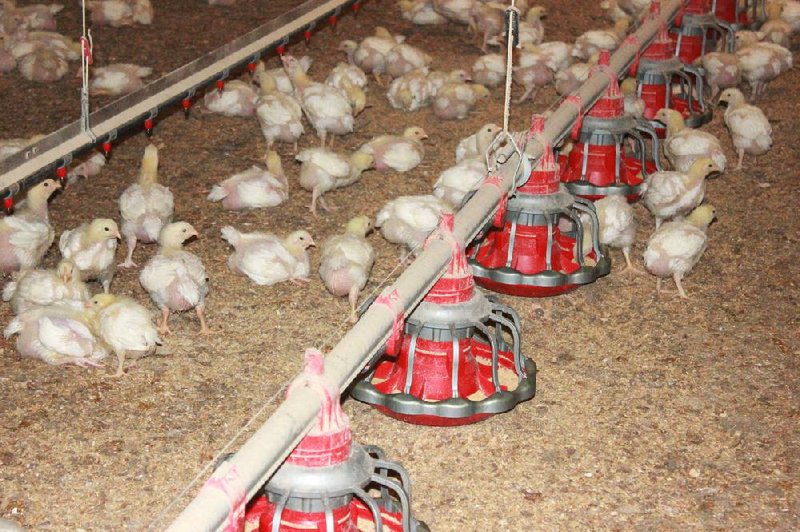Unlike older poultry houses where farmers had to manually open side tarp-like curtains if the buildings got too hot, today's chickens are cooled by computer.
Converting to climate-controlled chicken houses helps keep farmers competitive by saving money and producing better birds, said Worth Sparkman, spokesman for Tyson Foods Inc.
"They've moved from conventional barns with open, curtain-covered side walls to premium housing with solid side walls and computer-controlled ventilation and heating," Sparkman said. "The benefits of modern housing include a more comfortable living environment for the birds with improved ventilation and more uniform temperatures through the barn, as well as energy savings."
Kirk Houtchens, who has raised chickens for the past 24 years, is a contract grower for George's Inc., a Springdale-based chicken processor. At Buena Vista Farms in Decatur, Houtchens has four state-of-the-art chicken houses that cost him close to $1 million to build.
Each house is run from a control room that electronically monitors temperature, ventilation, water, feed and lighting. The computerized system aids in production. Before he invested in the new houses, he raised 92,000 chickens in a little over a month. Now, he can produce 140,000 chickens in that time.
"It raises a lot better bird," Houtchens said. "There is a lot more monitoring than there used to be, but it allows farmers not to be out there [all the time]."
Johnny Williams, co-owner of Reliable Poultry, a poultry supply company, said most people don't know how modern-day chicken houses operate.
"When people hear about poultry houses, they tend to think about the negatives with curtain-sided chicken houses, but with the new technology they have a good life," he said of the birds. "It's totally different now."
"It's about creating a more even temperature so the birds aren't stressed," Williams said. "In the curtain-ventilated houses the birds weren't comfortable. If it was 80 to 90 degrees outside, it was that hot inside, but now it is environmentally controlled.
COMFORTABLE CHICKS
In the control room for one of Houtchens' chicken houses, three boxes control a range of features. Nine sensors, one per heat zone, are strung throughout the 520-foot structure and send information back to the control room where a computer interprets the data and makes changes.
"In your home you only have one thermostat that controls the entire house -- one room might be cold and one might be hot -- it's hard to regulate," Houtchens said. "In the [poultry] houses, having more sensors in zones allows me to keep the temperature uniform."
If cool air is needed, the computer can automatically open side vents and tunnel doors so air can be pulled from one end of the house. The side vents have cool cells, which are black pads that have water trickling through them. The air can be pulled through the cells into the house, creating cool air even in high temperatures. Automated sprinklers can spray a small amount of water onto the birds' feathers when the vents and doors are opened, which helps cool the chickens.
"To cool a chicken house with an air conditioner would be expensive," Houtchens said. "We rely on wind speed to cool the birds and keep the birds comfortable. Sprinklers, foggers, cool pads and evaporative cooling are the only options available that are economical."
If the house is too cold, the computer can open attic vents to pull in air that's been warmed by the sun.
"We try to bring in as much preheated air as possible," Houtchens said. "The technology helps me with saving fuel."
Dennis Brothers, a poultry housing specialist with the National Poultry Technology Center, said using the new cooling and heating methods saves on energy costs.
"It's the most beneficial for gas savings -- you don't have the heating cost and there is better bird performance," Brothers said. "If we can remove or give the birds heat, it makes them more comfortable in their environment."
MOOD LIGHTING
Lighting is essential in chicken production. It is used to get the birds to put on weight and can determine how they interact with one another, growers said.
After chicks hatch, they are moved into chicken houses. Houtchens uses compact fluorescent lights until the birds learn about their new environment. "I start the lights as bright as I can get them to help them learn where to feed and water," he said.
It is the brightest light they will see during their 30-plus days on the farm. Once the birds are a few days old, Houtchens switches from fluorescent lighting to light-emitting diode. The LED lights are spaced in two rows, one every 20 feet. The computer controls the lights and dims them over time. By day 18, the LED lights are at their lowest setting.
"We use lower light to keep them [the birds] calm so they don't run around a lot and play," Houtchens said. "Low light lowers their stress and keeps the chickens from picking on each other."
Brothers said chicken behavior isn't the only reason for using LED dimmers. They also reduce electricity, which reduces the overall cost to raise the birds.
"It's longer lasting, and it costs less to operate," he said.
The computer also monitors water pressure and feed levels. If Houtchens' houses lose electricity or water pressure, run out of feed, or get too hot or cold, the system sends him text-message alerts.
He can use his smartphone or computer to monitor the houses and make small ventilation or temperature changes in them, allowing him to spend less time physically at the houses.
"I can control it from anywhere," he said. "It allows me to be a more competitive producer."
Sunday Business on 05/18/2014
